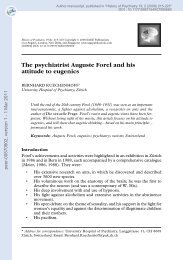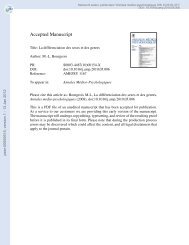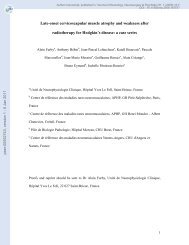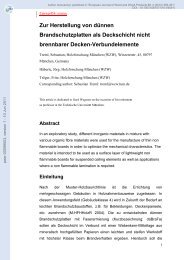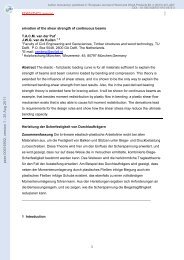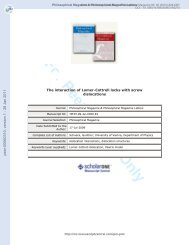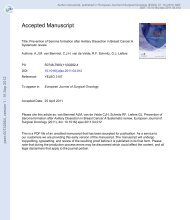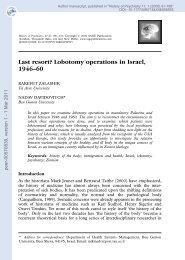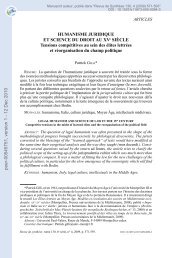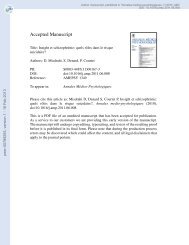Cosheaves and connectedness in formal topology
Cosheaves and connectedness in formal topology
Cosheaves and connectedness in formal topology
Create successful ePaper yourself
Turn your PDF publications into a flip-book with our unique Google optimized e-Paper software.
Now a ⊳ ⋃ γ∈π 0(a) (≤γ a), so b ↓ g − a ⊳ ⋃ γ∈π 0(a) b ↓ g− (≤ γ a), <strong>and</strong> by def<strong>in</strong>ition<br />
if afb <strong>and</strong> <strong>in</strong> a (γ) = δ then b ↓ g − (≤ γ a) ⊆ (≤ δ b).<br />
Corollary 22. If X = (P, ≤, ⊳) is locally connected, then so too is any <strong>formal</strong><br />
<strong>topology</strong> homeomorphic with X.<br />
Proposition 23. Let X = (P, ≤, ⊳) be locally connected, equipped with π 0 <strong>and</strong><br />
≤ γ . Let us def<strong>in</strong>e covers on ∑ a∈P π 0(a) by<br />
(a, γ) ⊳ V if (≤ γ a) ⊳ ⋃ {≤ δ b | (b, δ) ∈ V }.<br />
peer-00821313, version 1 - 9 May 2013<br />
1. ( ∑ a∈P π 0(a), ≤, ⊳) is a <strong>formal</strong>ly locally connected <strong>formal</strong> <strong>topology</strong>. (Here<br />
we shall write π ′ 0 for its connected components cosheaf.)<br />
2. There is a homeomorphism p : ( ∑ a∈P π 0(a), ≤, ⊳) → X def<strong>in</strong>ed by (a, γ)pb<br />
if (≤ γ a) ⊳ b.<br />
3. Its <strong>in</strong>verse s is def<strong>in</strong>ed by bs(a, γ) if b ⊳ (≤ γ a).<br />
4. The unique homomorphism Cosh p(π ′ 0) → π 0 is an isomorphism.<br />
Proof. We shall not prove the parts <strong>in</strong> the order of the statement. First, let<br />
us def<strong>in</strong>e relations p ⊆ ( ∑ a∈P π 0(a)) × P <strong>and</strong> s ⊆ P × ( ∑ a∈P π 0(a)) as stated<br />
<strong>in</strong> parts (2) <strong>and</strong> (3). Then Lemma 17 says that s − (a, γ) ↓ s − (b, δ) ⊳ s − ((a, γ) ↓<br />
(b, δ)) <strong>and</strong> we can deduce that s − V 1 ↓ s − V 2 ⊳ s − (V 1 ↓ V 2 ) for any subsets V 1 , V 2<br />
of ∑ a∈P π 0(a). Also, we see that (a, γ) ⊳ V iff s − (a, γ) ⊳ s − V (although we<br />
have not yet proved that this gives a <strong>formal</strong> <strong>topology</strong>).<br />
Next, we prove that c ⊳ s − p − c ⊳ c for each c. When we know that p <strong>and</strong><br />
s are both maps, this will tell us that s; p = Id X . For s − p − c ⊳ c, if bs(a, γ)pc<br />
then b ⊳ (≤ γ a) ⊳ c. For c ⊳ s − p − c, we use that (≤ ε c) ⊆ s − p − c for every<br />
ε. It follows that V ⊳ s − p − V ⊳ V for each V ⊆ P . Putt<strong>in</strong>g V = s − (a, γ)<br />
we deduce that s − (a, γ) ⊳ s − p − s − (a, γ) ⊳ s − (a, γ), which is equivalent to<br />
(a, γ) ⊳ p − s − (a, γ) ⊳ (a, γ). Now, when we know that p <strong>and</strong> s are both maps,<br />
it will follow that they are mutually <strong>in</strong>verse.<br />
Next, ⊳ is a <strong>formal</strong> <strong>topology</strong>. If (a ′ , γ ′ ) ≤ (a, γ) then (≤ γ′ a ′ ) ⊆ (≤ γ a), so<br />
(a ′ , γ ′ ) ⊳ (a, γ). If (a, γ) ⊳ V i (i = 1, 2), then<br />
s − (a, γ) ⊳ s − V 1 ↓ s − V 2 ⊳ s − (V 1 ↓ V 2 )<br />
so (a, γ) ⊳ V 1 ↓ V 2 . If (a, γ) ⊳ V ⊳ W , then s − (a, γ) ⊳ s − V ⊳ s − W so<br />
(a, γ) ⊳ W .<br />
Next, s <strong>and</strong> p are maps. The case of s is straightforward. For p, if (a, γ) ⊳<br />
V pb then s − (a, γ) ⊳ s − V ⊳ b so (a, γ)pb. If (a, γ)pb ⊳ U, then s − (a, γ) ⊳ b ⊳<br />
U ⊳ s − p − U <strong>and</strong> so (a, γ) ⊳ p − U. The rema<strong>in</strong><strong>in</strong>g two conditions are simple.<br />
At this po<strong>in</strong>t, we have proved that ( ∑ a∈P π 0(a), ≤, ⊳) is a <strong>formal</strong> <strong>topology</strong>,<br />
<strong>and</strong> (parts (2) <strong>and</strong> (3)) it is homeomorphic to X by maps p <strong>and</strong> s = p −1 .<br />
To show it is <strong>formal</strong>ly locally connected, suppose (a, γ) ⊳ V . We must show<br />
that (a, γ) ↓ V has exactly one equivalence class with respect to the equivalence<br />
relation ∼ generated by ≤. By Lemma 17 we can f<strong>in</strong>d (a ′ , γ ′ ) ≤ (a, γ) with<br />
17



